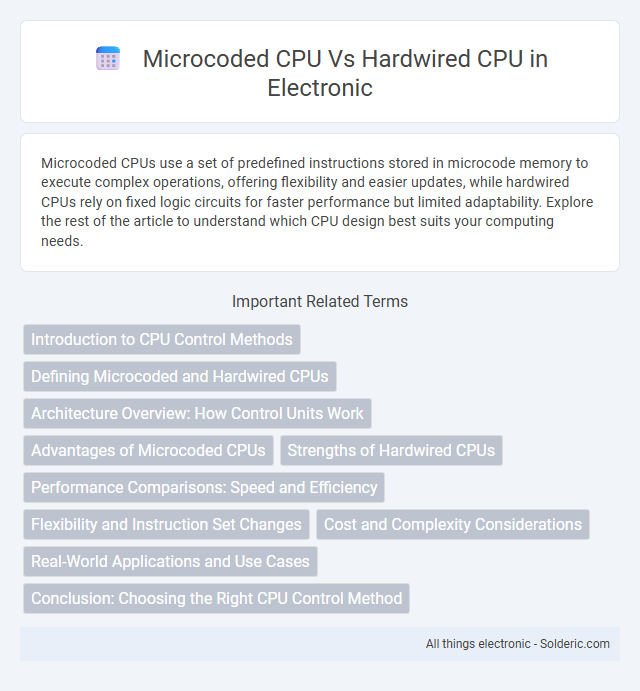Microcoded CPUs use a set of predefined instructions stored in microcode memory to execute complex operations, offering flexibility and easier updates, while hardwired CPUs rely on fixed logic circuits for faster performance but limited adaptability. Explore the rest of the article to understand which CPU design best suits your computing needs.
Comparison Table
| Feature | Microcoded CPU | Hardwired CPU |
|---|---|---|
| Control Mechanism | Uses microinstructions stored in control memory | Uses fixed combinational logic circuits |
| Design Complexity | Simpler to design and modify | Complex and less flexible design |
| Flexibility | Highly flexible; easy to update instruction set | Rigid; difficult to modify once designed |
| Performance | Generally slower due to microinstruction interpretation | Faster execution with direct control signals |
| Cost | Lower initial development cost | Higher cost due to complex hardware |
| Instruction Set Complexity | Supports complex instruction sets easily | Best suited for simple instruction sets |
| Examples | IBM System/360, Modern RISC Processors | Early Intel CPUs (e.g., 8085), Simple microcontrollers |
Introduction to CPU Control Methods
Microcoded CPUs implement control signals through a sequence of microinstructions stored in memory, providing flexibility and easier updates for complex instruction sets. Hardwired CPUs generate control signals via fixed logic circuits, resulting in faster processing speeds but limited adaptability to new instructions. Your choice between microcoded and hardwired CPUs depends on the trade-off between control complexity and execution efficiency.
Defining Microcoded and Hardwired CPUs
Microcoded CPUs execute instructions using a sequence of microinstructions stored in control memory, allowing flexible and easily modifiable control logic. Hardwired CPUs rely on fixed combinational logic circuits to generate control signals, resulting in faster but less adaptable instruction execution. The fundamental difference lies in microcoded CPUs using stored microprograms for instruction decoding, whereas hardwired CPUs employ direct hardware logic designs.
Architecture Overview: How Control Units Work
Microcoded CPUs use a control unit that executes instructions through a sequence of micro-instructions stored in control memory, offering flexible and easily modifiable control signals. Hardwired CPUs have control units designed with fixed logic circuits that generate control signals directly, enabling faster instruction execution but limited adaptability. Understanding your system's needs can help determine whether microcoded architecture's programmability or hardwired architecture's speed is more suitable for your applications.
Advantages of Microcoded CPUs
Microcoded CPUs offer enhanced flexibility by allowing updates or modifications to the instruction set through firmware changes without altering hardware. This adaptability simplifies complex instruction implementation and improves debugging efficiency, making your system more versatile. Microcoded designs also facilitate easier maintenance and support for backward compatibility, extending the CPU's operational lifespan.
Strengths of Hardwired CPUs
Hardwired CPUs excel in speed and efficiency due to their fixed control logic, which allows for faster instruction execution compared to microcoded CPUs. Their design results in lower latency and higher performance in real-time processing applications where rapid response is critical. The simplified hardware architecture of hardwired CPUs also leads to reduced manufacturing complexity and power consumption, making them ideal for embedded systems and specialized processors.
Performance Comparisons: Speed and Efficiency
Microcoded CPUs offer greater flexibility by executing complex instructions through microinstructions, resulting in slower instruction cycle times compared to hardwired CPUs. Hardwired CPUs achieve higher speed and efficiency in performance due to direct hardware control paths that minimize instruction decoding time and pipeline stages. While microcoded designs simplify instruction set modifications, hardwired CPUs excel in scenarios demanding maximum throughput and low-latency execution.
Flexibility and Instruction Set Changes
Microcoded CPUs offer greater flexibility by allowing instruction set changes through updates to the microprogram, enabling easier adaptation and enhancement without hardware modifications. Hardwired CPUs have fixed instruction sets hard-coded into their circuitry, making them faster but less adaptable to new instructions or architectural changes. Your choice depends on whether you prioritize adaptability or execution speed for your computing needs.
Cost and Complexity Considerations
Microcoded CPUs incur higher initial design costs due to the need for a microprogram storage and control memory, but they simplify complex instruction implementation, reducing overall development complexity. Hardwired CPUs feature lower unit production costs and faster execution speeds but demand intricate, fixed logic design, increasing complexity and time in the design phase. Cost-effectiveness depends on application scale, with microcoded CPUs favored for flexibility in complex instructions and hardwired CPUs preferred for high-speed, cost-sensitive environments.
Real-World Applications and Use Cases
Microcoded CPUs excel in complex instruction set computing (CISC) environments, powering general-purpose processors like IBM System/360 and modern x86 architectures, where flexibility and ease of updates are critical. Hardwired CPUs dominate in real-time embedded systems such as automotive control units and industrial automation, offering faster instruction execution and lower latency through fixed control logic. The choice between microcoded and hardwired designs hinges on application requirements for scalability, performance, and cost-efficiency in diverse domains like consumer electronics and aerospace.
Conclusion: Choosing the Right CPU Control Method
Selecting between a microcoded CPU and a hardwired CPU depends on your specific application requirements, where flexibility and ease of modification favor microcoded designs, while speed and efficiency are strengths of hardwired control units. Microcoded CPUs allow easier updates and complex instruction sets, making them ideal for general-purpose computing, whereas hardwired CPUs excel in real-time and high-performance systems due to their faster instruction execution. Understanding your performance needs, system complexity, and upgrade potential will guide your choice for optimal CPU control method implementation.
Microcoded CPU vs Hardwired CPU Infographic

 solderic.com
solderic.com